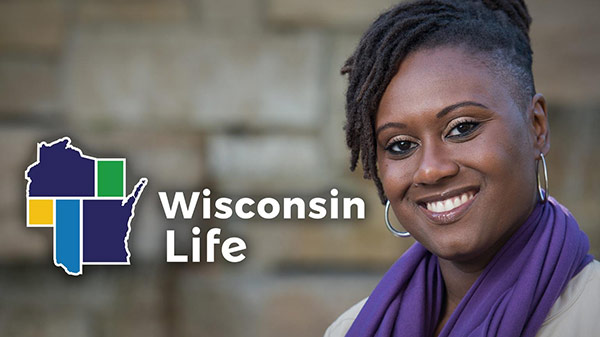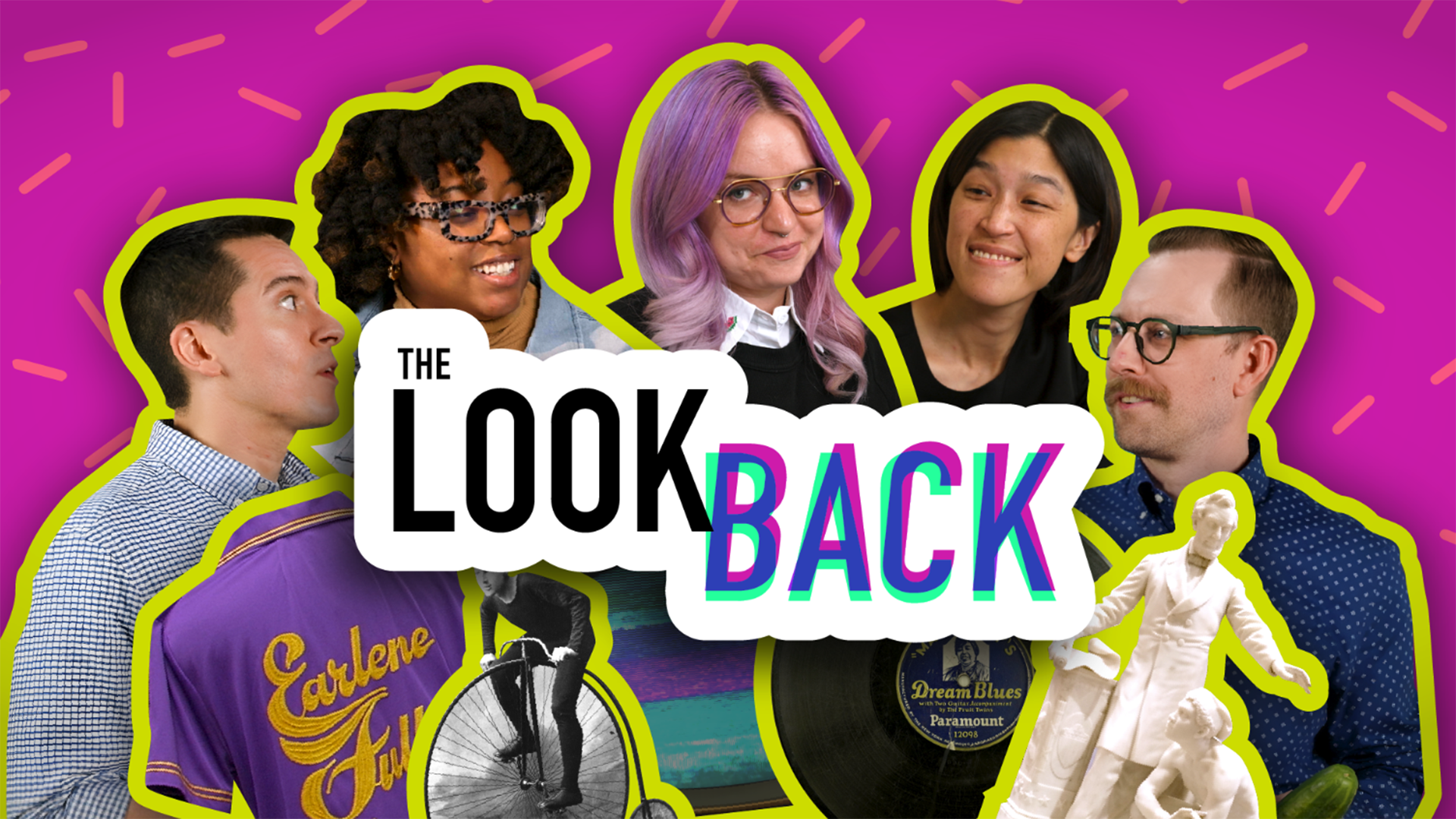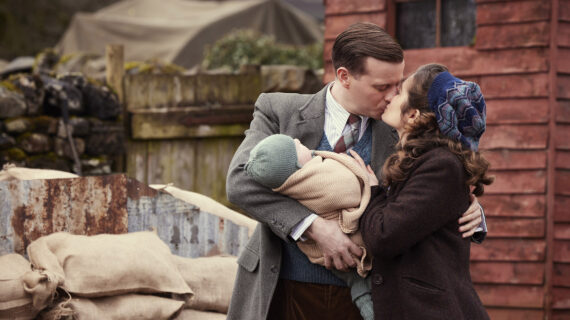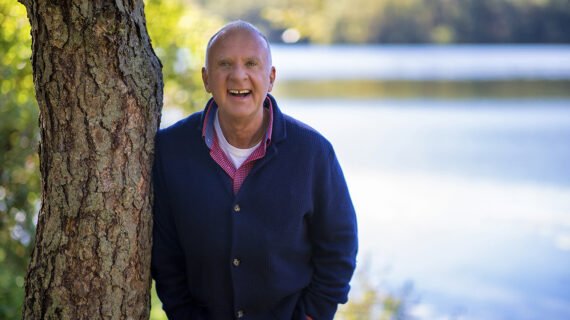– John McGivern: I am in the largest city in Minnesota, known as the City of Lakes.
– Announcer: We thank the underwriters of John McGivern’s Main Streets, because without them, we couldn’t make this show.
– Heiser Automotive is honored to help John McGivern and his team arrive safely to many Main Streets.
We are committed to remaining true to the Heiser way: Do what’s right for our customers, our employees, and the communities we serve.
We are happy to help.
– You’ll find your bright spot in Sun Prairie, Wisconsin.
– Yes, Greendale is beautiful on the outside.
But it’s what’s inside that counts.
Who doesn’t love opening a door to beautiful treasures?
Whether you’re a collector, in need of the perfect gift, or would like something special for yourself.
Come on in!
You just gotta see Greendale.
– Your community’s best selfie spot is Your-Type!
– There’s no place like Oconomowoc.
Explore, play, shop, stay.
Visit Oconomowoc!
– My father taught me that to make great bakery, you have to do it the right way.
O&H Danish Bakery, where kringle traditions begin.
– From the Green Circle Trail to Point Brewery, you’ll find more fun in Stevens Point, Wisconsin.
– Announcer: Horicon Bank, West Bend Insurance Company, the Friends of Main Streets, and the Friends of PBS Wisconsin.
– ‘Cause these are our Main Streets Something ’bout a hometown speaks to me There’s nowhere else I’d rather be The heart and soul of community’s right here On these Main Streets – Minneapolis is the largest city in the state of Minnesota, with 13 lakes and 430,000 people.
This city is split in two by the Mississippi River, and sits in the middle of the eastern edge of the state of Minnesota.
It is about 30 miles west of the state of Wisconsin and 12 miles west of Saint Paul.
Minneapolis has 83 neighborhoods.
And this week, I’m gonna show you Northeast Minneapolis.
Minneapolis is a Mississippi River town.
Why is it so different than the others, Emmy?
– Emmy Fink: Take a look right here behind us.
St. Anthony Falls, the only natural waterfall on the river.
– John: Oh, really?
– Emmy: Mm-hmm.
– I would’ve bet that there were more.
– Right?
– I bet it helped this city grow.
– Emmy: Big time.
It provided power for a lot of different industries.
And back in the day, this was the milling and the flour capital of the world, right here.
– John: What companies started here?
– So big names, General Mills, Pillsbury.
Beer-making was big here, too.
Grain Belt Brewing, their signs are still part of the iconic Minneapolis skyline.
– So we’re right by the river, down by the river, really close to downtown, but we’re headed northeast.
What’s special about Northeast?
– Two MVPs of Northeast, art and food.
– John: Oh, good, I love art.
– Emmy: I love food.
– Maybe we should get you– You wanna eat?
– Yes!
– Okay, I knew that this would make you make happy.
– Thank you.
– Okay.
– Take a look at this.
I’m pretty excited about Nordeast Anchor Fish & Chips.
Look at the size of this thing!
Oh, yeah, oh, yeah.
I’m not sharing.
– John: We are inside Clay Squared.
This is really impressive.
– Josh Blanc: Thank you.
– John: Yeah, it’s gorgeous.
How long you been doing this?
– Almost 30 years.
– John: Who’s your customer here?
– Josh: It’s really people who love their homes, usually homes from the 1890s to the 1950s.
They go to a big box store, and there’s white, off-white, and beige.
Works for a lot of things, but they’re like, “Where’s all the color?”
A lot of the older homes have these colors in them.
The mid-century tile is America’s true contribution to the tile world.
So we’re gonna make some glaze today.
This is gonna the copper patina.
And this turns out to be, like, matte green.
We’re just painting it on.
So why don’t we flip to the other side, if that would work?
You don’t wanna keep running it over again, so you put a blob on there and spread over.
– John: You cover it so well!
– I got 30 years on you.
– You do.
[Josh laughing] Is there still learning involved?
– Josh: Always.
– John: There is?
– Josh: Yes.
The kiln has its own magic.
I give it some direction, and then things come out.
– Talk about the life of an artist in this neighborhood.
– Josh: Thirty years ago, the artists moved from downtown Minneapolis to here.
Now we have 17 art buildings and we have 1,200 artists, what is considered the city’s designated Arts District.
We are the economic engine of this part of town.
We create a lot of jobs, we create a lot of beauty.
– John: And what is this called?
– Glenda Janzen: Polymer clay.
– Polymer clay.
– Clay.
Here is an example of what she does.
– John: That’s crazy.
The work to do that is crazy.
– Right, yes.
– Like a lot.
– Yes, yes, it is.
And then she pulls it so that it becomes this.
– John: How does it stay… – Glenda: Together?
It just stays, I don’t know.
It’s the magic of polymer clay.
[laughing] There’s the magnets.
– John: Did they start off as a… – Glenda: Yes.
– John: Oh, they did?
– Glenda: Yes.
– And they were pulled.
– Mm-hmm.
– And I think that’s what the whole Arts District is about, is, like, you get to see people making something.
They’re inventing things, they’re small businesses.
Just amazing humans making things.
– John: It’s very cool.
– I guarantee this is one of the most unique homes on Airbnb.
It’s the Wolf House in Northeast.
The home’s first owner was an artist.
Every single room she used as her canvas for over 30 years.
There is something around every corner.
This home is used for community events, artist retreats, but I’m telling you, you’re gonna wanna rent this house for the night, because, check this out, this is the shower.
Oh, yeah, it’s like you’re standing in a waterfall!
Excuse me.
[shower door closing] Ahh.
[water splashing] – I’ve been doing this for 15 years, and I’ve never seen anything like this at all.
– Adam DeJarlais: Great.
– John: It’s called Twelve Vultures.
– People have been to shops similar, but they’ve never seen it quite on this level as far as the aesthetic.
– What’s all in here?
– So it’s a lot of natural history.
I like to classify more as curiosities, conversation pieces.
It’s everything, it’s eccentric, so… – Right.
– It’s a lot of decor.
– Decor?
– Yeah.
– Let’s look around.
– Sure.
We have our shop cat.
We call him Sir.
– John: It’s good to have a cat.
White wolf.
– Adam: Yeah, he’s kind of watching the door.
– John: Right!
– Adam: You know?
This is a partial ulna of a woolly mammoth.
– Katrina Rivard: It’s a museum where everything is for sale.
– It’s amazing.
– Mm-hmm.
– John: What’s your specialty?
– I’m kind of a do everything.
So I also make a lot of things that sell in the shop.
Dream job.
– Good for you.
Good for you.
– Thank you.
– Customer-wise, who’s your customer?
– Anybody, just curious people in general.
– He’s the greeter.
Cat eye shells?
Take a look at these.
They’re cool.
What is this?
Emu eggs?
– Yeah, yeah, that’s their natural color.
– John: These are cool.
– Adam: Yep.
– There seems to be a lot of skulls here.
– Yeah, yeah, a lot of skulls.
So none of it is taken– or no life is taken for the purpose of that decoration.
– John: Yeah.
Roe deer.
– Adam: Roe, R-O-E.
But these are plentiful all throughout Europe and Asia.
– John: Wow, you’ve got a lot of stuff.
– Adam: Yeah, yeah.
– John: And how does a collection like this start?
– Adam: I’ve only been at this for about 12 years.
I had a collection of my own, and it gets bigger, and I just keep finding things.
This is a toco toucan.
This would be like your Froot Loops toucan there.
That’s the skull, and that’s the beak.
– Do you have husbands and wives?
And are they as intrigued?
– Yes.
– Yeah.
– They are.
– Adam: I’ll tell you, anything here is something that I would happily put in my home.
– Guess what this is.
This is a sea urchin.
Who knew?
– Adam: A Hercules beetle.
– John: And where are they plentiful?
– Africa.
– Africa.
– Yeah.
– John: It’s really good.
– Adam: Hey, collection is what you like, you know, and you can’t force it, otherwise it’s not enjoyable.
– John: As I said, never saw anything like this.
[Adam laughing] – Adam: Like, I want that aesthetic that’s different enough that just evokes that reaction.
[both laughing] – I’m in Northeast Minneapolis, but some locals say that I’m saying “Northeast Minneapolis” wrong.
How am I mispronouncing “Northeast Minneapolis?”
[playful music] – Now, I know the sign says “Northeast,” but that is not how you say it.
The locals say Nordeast.
“Nordeast,” that’s right.
It’s a good Midwest accent, dontcha know?
– I am on Washington Street.
The next street over?
Adams, then Jefferson, then Madison, then Monroe.
Do you get it?
They’re presidents in the order that they were president.
I heard that they named those streets so that immigrants could pass the citizenship test.
I don’t know if that story is true, but I love that story.
[gentle music] – So we’re on Nicollet Island.
– Barry Clegg: Nicollet Island.
It’s an island in the middle of the Mississippi River, Downtown Minneapolis on one side and Northeast Minneapolis on the other side.
– Can we talk about how you got this house?
– This was sort of a hippie ghetto in the ’70s and ’80s.
– Okay.
– Barry: So the park board condemned all the houses on the island.
So it decided, “Okay, we will sell these houses to people who will fix them up on a land lease,” a 99-year land lease.
It was $5 to buy that.
– It was $5.
– $5, and I’ve got some pictures of my mother, who’s now passed on, but walking through the house with this horrified look on her face.
It was completely gutted on the inside.
It had no plumbing, it had no electrical.
All that had been stripped out.
But it worked out fine.
– John: And it’s a lovely home.
– Barry: Thank you.
– John: Do you love the neighborhood?
– Barry: Oh, absolutely.
– John: Do you?
– Barry: I mean, I work downtown.
– John: Okay.
– Barry: And you forget that you’re near downtown until you walk around the corner and… – That’s amazing, there it is.
– Barry: The river used to be very, very industrial.
There were lumber mills, there were flour mills, there were roofing companies.
Nobody really wanted to live along the river ’cause it was dirty and there were trains running all the time.
And that’s changed in the last 20 years.
I mean, there used to be, like, donkeys that lived here and stuff.
– There were what?
– Donkeys.
– You didn’t say it was a circus island.
Did somebody build this island?
– Barry: No.
The island’s always been here.
The Mississippi River has thousands of islands, but most of ’em are two feet high, so nobody builds on them because they flood every year.
– John: Right.
– Barry: But this is about thirty feet above the river right here.
And it sits on a limestone cap, so it’s… – John: Solid.
– Barry: If you try and dig down about a foot here, you’ll run into limestone.
– Were there any second thoughts about moving here?
– None.
– John: Not a one.
– Not a one.
– John: I would’ve put my name in that lottery as well.
I swear I would’ve.
If you’re a foodie, Northeast Minneapolis is the place you really should visit.
They’ve got every sort of cuisine you can think of.
I am standing in front of the colorful Hai Hai restaurant, which is known for its inspired Vietnamese fare.
A visit to Northeast would not be complete without a visit to Young Joni.
Have you ever heard of Korean-inspired pizza?
That’s one of their many specialty pizzas.
Our global tour continues over at Holy Land, which is a restaurant, a bakery, a grocery, a deli.
It’s been a Mediterranean staple in this neighborhood since 1986.
There’s a hummus factory in there!
Yeah, they whip up big tubs of hummus that they ship out to global customers.
So the tour now ends because I’m hungry!
– The Polish presence in this neighborhood, well, it’s alive and well, especially when you look at this sign behind me: Surdyk’s.
They have been a landmark in this neighborhood since 1934 for, really, four of my favorite food groups.
Let’s count ’em: Liquor, wine, deli, and cheese.
I don’t think you need anything else.
– John: Take a look at that.
I am very excited about this.
So you’re what generation?
– Nick Kramarczuk: Third generation.
– Third, you’ve known this business your whole life, then.
– I started working here, slicing bread and serving people kolaches since I was 12 years old.
[John sighs] – John: Come on.
Is your dad still around?
– He’s still around, yeah.
He’s kind of semi-retired now, but he comes in here and gets his lunch and then bothers me, and then he’s off, so, yeah.
– Orest Kramarczuk: Yeah, I come in every day.
– Do you?
– Yeah, for fun.
– Yeah.
How’s he doing?
– Better than me.
– Is he?
[laughing] Have you heard that before?
– It’s nice to have it on film.
[all laughing] – That’s good, great.
– Yeah, it’s true.
A lot of satisfaction is that we’ve been able to retain this legacy.
– I’m still learning ’cause there’s so much involved in this business.
We have retail, wholesale sausage, a restaurant, and a bakery.
So that’s four businesses, and there’s probably another one in there somewhere that’s ready to go, you know.
– Let’s talk about the history of this place and why everybody said, “Have you been there yet?”
– Nick: We started in 1954 as just a tiny butcher shop.
My grandparents emigrated from Ukraine and started making sausage, and there were a lot of other Eastern European immigrants.
And the sausage they made reminded these people of their home.
– John: Home.
– Nick: So…
Most of our sausages are Eastern European varieties, but we branched out a little bit into other parts of the world.
Every culture, I feel like, has a sausage.
– John: And what sells?
– Nick: In terms of bakery, the kolachi pastries.
Those are really popular.
They sell out by 1 o’clock.
A lotta people don’t like prune.
I think it’s one of the best ones.
– They don’t know.
– They don’t know.
– John: Do they?
Well, they’re afraid because prune has a reputation for, you know.
– Yeah, that, too, yeah, you’re right.
[chuckling] And then in the restaurant, cabbage rolls.
We sell so many cabbage rolls, we can’t mix ’em in a mixing bowl anymore.
We have to use the Hobart.
You can imagine how much work it is to get this many leaves.
– John: Is this a easier one to deal with?
– You probably only need two.
You get that lined up on your hand.
You kind of want one at the top, one at the bottom, and then you take your meat portion, and you can start from the bottom, you can start from the top, it doesn’t really matter.
But you fold one side over.
And then the ends, you just push those in.
– John: Push ’em in?
– Nick: Yep.
– Is that your first one ever?
– My first one ever.
– Well, that’s a good place to start.
– Not so bad?
– Nick: We can watch Dolores.
She’s probably made, I don’t know, a million cabbage rolls.
Who knows?
Can’t even count.
[both laughing] – John: And it worked, didn’t it?
– Nick: It worked.
– John: Yeah.
– What do you think?
– It’s really good, isn’t it?
– Yeah.
– And it’s like the taste of history here.
– Yeah, we get people asking for five or six different things.
The Hungarian is sarma.
In Ukrainian, we call ’em holubtsi.
And in Polish, it’s a golumpki, and it always ends up being the same thing.
It’s a cabbage roll.
[laughing] – John: Wow, that’s so good.
– Nick: Yeah, you need a nap after you eat one of those.
Maybe skip the next meal, too.
[John laughing] – When it comes to getting around, there are so many options, and one is very unique.
What first-of-its-kind, getting-around option started right here in Minneapolis?
[playful music] – Minneapolis was the first place in the country to offer Segway tours– Human on a Stick.
That’s what the company’s called.
Thanks to them, you can bebop around the city on one of these.
I was a little nervous, I gotta say.
Bill gave me a great lesson.
He will for you, too.
And you’re gonna have so much fun.
[cheering] – We’re at a company called Graco, and I’m sure you know exactly what they do.
You don’t.
You know what we presumed?
– Mark Sheahan: The baby products maker.
– Of course.
– Of course, yeah.
– It’s like, “A car seat?
I can’t wait!”
That’s not what we’re talking about.
– The company was started back in 1926 by two brothers.
They designed a product.
It was a air-operated grease gun for lubricating cars.
And that was the genesis of Graco.
– John: It’s a big campus.
– Mark: It is a big campus, yeah.
We make high-viscosity pumps that move materials that are really important to customers, like paints, adhesives, sealants.
– Angie Wordell: Yeah, this is a sample we make.
This one actually is our Merkur.
This is done for, like, finishing of cabinetry in homes.
– John: Okay.
– Angie: This pumps the lacquer that finishes, that sprays on the cabinetry that gives it that nice sheen look.
– Today, we’ve got about 500 employees that are on this campus, and we have about 4,000 employees worldwide.
– Where are we standing right now?
– The machining training cell that we have for all of our Minnesota locations.
– John: So these are new machinists that just came to your company?
– Angie: Correct.
These are machinists that graduated the technical school.
We bring ’em into this program, and they take five months to train across all of our pieces of equipment.
And that way when they graduate, they’re fully trained on our equipment, so they can be successful in the factory.
– Good to see you.
What are you working on?
– Well, on a DCi motor.
– John: Uh-huh.
– And on that side, he’s doing the gear side over there.
– John: The gear side?
Can you do the gear side as well?
– Yeah.
– Oh, you can.
– Yeah, yeah.
– You can do it all?
– You have to.
What if he’s not in?
– Can I send him home?
– Yeah, you can send him home.
– Angie: Aw!
– We’ve grown a lot organically by continuing to launch new products to our customers.
– John: Yeah.
– Mark: As their needs change, we try to adapt with them.
As the materials they’re using change, we make the equipment that goes along with it.
– Angie: So the great thing about this is this is automation that we’ve done in-house for Graco.
We’ve never had an automation project that has cost anybody their job, and we’ve actually been able to use those people to do other jobs that we really need them to do.
– John: And I think that’s really important to hear, that automation did not replace.
That thing takes yoga, can’t you tell?
Nimble!
[chuckling] – Mark: Really, I would say that the core of this company is designing, developing, launching products that our customers want.
– Is there anything you wanna surprise us with?
Like, what are you working on right now?
– No.
[both laughing] I could tell you, but I don’t think I could let you leave.
– Right, “And no one ever saw him again.”
– No one ever saw him again.
[laughing] – John: Thanks for talking to us.
– Angie: Yeah.
– There’s some great little neighborhoods in the Northeast.
This is one of ’em.
It’s called St. Anthony Main.
It’s the oldest part of town.
In fact, it was a city on its own until 1872, when it merged with the rest of Minneapolis.
And you can tell it’s the oldest part of town, take a look.
It’s cobblestone sidewalks, cobblestone streets.
So when you visit St. Anthony Main, wear comfortable shoes, okay?
This is the oldest continuously-used church in Minneapolis.
It was built in the 1850s by the First Universalist Society of St. Anthony.
And then in 1877, it was taken over by a congregation of French-Canadian Catholics.
And they have a tradition here that’s been going on forever: French meat pies.
That’s right, a French meat pie.
The best part of this, you buy it at the parish office.
And when we picked this up, we asked, “What are the secret recipes?”
And the person told us that only God knows.
Oh, wow!
I love giving old stuff new life in my condo in Milwaukee.
– And I love thrifting.
– John: So we’re here: Architectural Antiques.
Can’t wait.
– Scott, tell us your part of the story, how this all started.
– Scott Anderson: Well, I actually bought the business from a friend of mine who did it, and then I’ve just been doing it since about ’89.
– You were three when he started this?
– Ian Anderson: I was three.
He swore that I would never be part of the business, and go on and find… – John: Liar.
– …something better to do, but… – And I love having him here.
– I’m sure.
– Part of the reason I’m still doing it.
People would search out, you know, quality products that kept the period of the house, so restoration and renovation was kind of an art, and that’s kind of how the business grew.
– So I live in a building that was built in 1928.
So to walk in here, it’s everything that is ever, like, exciting to me.
This is too much for me!
– Scott: I think we’ll swing to hardware first.
We call it “house jewelry.”
– John: House jewelry!
– Scott: Sort of to elevate it.
That is a doorknob.
Probably early 1900s, maybe the 1890s, yeah.
That one’s beautiful.
– John: Oh, wow.
Does this not remind you of Grandma’s house?
So great.
– Ian: We got church lights next to schoolhouse lights.
This is up front, where we have what we call art glass.
This is what we call our deco fixture area.
We’re getting a little later in the ’30s and ’40s.
– Scott: Lighting is a big deal for us because they bring some kind of history and some kind of romance and renaissance to the room that they’re in.
– I’ve changed light bulbs, and that is about it as far as my knowledge.
– I mean, that’s more than some people.
– Scott: We wanna make sure that lights are safe to go hang in someone’s home with certainty that it’s gonna be safe.
– Ian: These are our lighting technicians with Maddie and Sasha.
– What’s been, like, the coolest piece that you’ve worked on?
– Maddie: Probably some big crystal chandeliers.
I mean, people love ’em in their homes.
– Sasha: I really liked all of the cleaning up and vintage repair.
– No day’s ever the same.
– No, yeah.
– This business has always been for the people who want to mix things up in their house– new with old.
That’s how we’ve thrived.
– Ian: I think that the more education that people have about their old home that they can maintain, the better it is for keeping those old homes around.
In a lot of ways, the most efficient house is the one that already exists.
– Emmy: All right, you have to stop now.
– Okay, take me by the hand.
– We’re signing off.
We’re signing off.
I’m getting him out of here, okay?
– Let’s go this way.
– He’s like this little child of mine.
Here in Northeast, it’s all about art, food, and then one more thing was suggested to us: dive bars.
Thanks, Alicia.
– Alicia: Yeah.
– We’re here at 331 Club.
And this place has been a bar since 1899.
Cheers!
This is The 1029 Bar, and let me tell you, it’s a classic.
They’ve got karaoke, they’ve got pull-tabs, they’ve got cold beer, they’ve got a meat raffle, and they’ve got bras on the ceiling!
Cheers!
Third stop, third beer.
Don’t worry, I’m not driving.
We’re at Grumpy’s.
This place opened up as a bar back in 1906.
Cheers to the no-frills dive bars in Northeast.
– John: We’re with the artist Michael Birawer, and this is his gallery.
What do you do?
– Michael: I do a lot of cityscape work.
In fact, I’ve given it a little name called Distortchitecture, which is combining the words distortion and architecture, taking landmark buildings and distorting them, if you will.
– John: How did you find that style?
– Michael: It’s just borrowing and stealing from Pop Art to Cubism to Surrealism.
– John: I heard there was a series of dive bars that you created.
– Michael: I really got a lot of interaction on social media when I kind of put it out there of, “What’s your favorite dive bar?
Which one speaks to you?”
One of the aspects I really love is 3D paintings.
You know, you can see a little tunnel there.
I actually put myself and my wife and then the piece with our dog.
– John: Very good.
How do you start?
– When I was working on this drawing, I think it was one piece of paper, and then I started taping other pieces of paper, and then eventually, it became a scroll I was rolling out.
This was a series of pop art flowers.
They’re almost like celebrity portraits of everyone’s favorite flower.
– You had some cutouts here.
– Yes, yeah.
A lot of cutting out, a lot of sanding.
– With this one!
Is there a more joyous period of creating?
– The way I work, it’s a very soothing, just positive experience for me.
Life can be hard, and so it’s nice to have a little bit of escape just to kind of just make art.
There’s just a ton of support for the arts in Minneapolis-Saint Paul.
I’d like to think that my work kind of comes out of that inspiration.
– John: Yeah, that’s so great.
I love it.
– Michael: Thank you.
– John: I really do.
[both laughing] [upbeat music] – I’m not so sure about the City of Lakes.
I think it should be “the city of art and food surrounded by lakes.”
– That’s good.
– Yeah.
– Do not forget the tight-knit community that feels like a small town that’s so close to a real downtown.
– For sure.
– You know what I say?
– What?
– I say… Nordeast Minneapolis does not disappoint.
– Nordeast, you’re a local!
– There’s nowhere else I’d rather be The heart and soul of community’s right here – You want us to pretend like we’re talking, or?
– Yeah.
[laughing] – Is this my better side?
– Yeah, all of it.
– All of this, this side!
[both laughing] – It kind of reminds me of our Zero Turn lawnmower.
– That’s one of the many– [blowing raspberry] – Don’t you do– I did it wrong again!
– Lois: Yes!
– Aah!
That’s just– [all laughing] – Announcer: We thank the underwriters of John McGivern’s Main Streets, because without them, we couldn’t make this show.
– Heiser Automotive is honored to help John McGivern and his team arrive safely to many Main Streets.
We are committed to remaining true to the Heiser way: Do what’s right for our customers, our employees, and the communities we serve.
We are happy to help.
– You’ll find your bright spot in Sun Prairie, Wisconsin.
– Yes, Greendale is beautiful on the outside.
But it’s what’s inside that counts.
Who doesn’t love opening a door to beautiful treasures?
Whether you’re a collector, in need of the perfect gift, or would like something special for yourself.
Come on in!
You just gotta see Greendale.
– Your community’s best selfie spot is Your-Type!
– There’s no place like Oconomowoc.
Explore, play, shop, stay.
Visit Oconomowoc!
– My father taught me that to make great bakery, you have to do it the right way.
O&H Danish Bakery, where kringle traditions begin.
– From the Green Circle Trail to Point Brewery, you’ll find more fun in Stevens Point, Wisconsin.
– Announcer: Horicon Bank, West Bend Insurance Company, the Friends of Main Streets, and the Friends of PBS Wisconsin.
– Oh, yeah, that’s it, a little bit to the right.
– Lois: Hey, what are you two– okay, that’s it, I quit.
– Don’t be so sensitive, Lois.
[chuckling]
Search Episodes

Donate to sign up. Activate and sign in to Passport. It's that easy to help PBS Wisconsin serve your community through media that educates, inspires, and entertains.
Make your membership gift today
Only for new users: Activate Passport using your code or email address
Already a member?
Look up my account
Need some help? Go to FAQ or visit PBS Passport Help
Need help accessing PBS Wisconsin anywhere?

Online Access | Platform & Device Access | Cable or Satellite Access | Over-The-Air Access
Visit Access Guide
Need help accessing PBS Wisconsin anywhere?

Visit Our
Live TV Access Guide
Online AccessPlatform & Device Access
Cable or Satellite Access
Over-The-Air Access
Visit Access Guide
 Passport
Passport









Follow Us